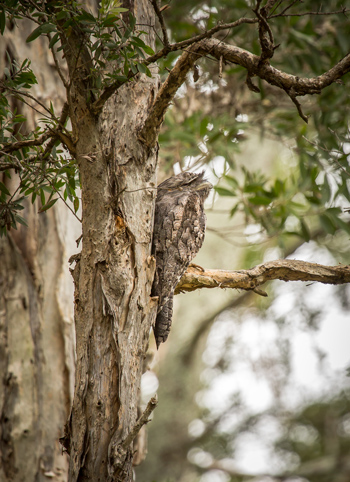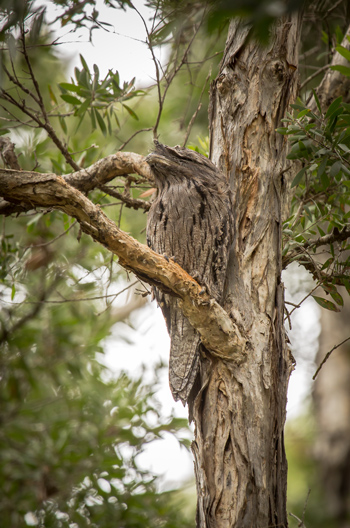Utah County Birders
Newsletter
|
|||||||||||||||||||||||||||||||||||||||||||||||||||||||||||||||||||||||||||||||||
 |
Contents
June Meeting
Upcoming Field Trips
Captain's Log
Bird of the Month
Field Trip Reports
Thursday, June 14, 2018, 9pm: Owling Nebo Scenic Loop
Friday & Saturday, June 1-2 -
6:00 am
WASHINGTON COUNTY
We will be doing a Washington county trip. Put it on your schedule for June 1st
and 2nd. You will need your own accommodations.
We will meet at the McDonald's on Bluff Street Friday morning June 1st at 6:00
am to head out to Lytle Ranch. Bring a lunch and snacks. On the way back we will
stop by Utah Hill to look for the Black-chinned Sparrow, then look for a Bell's
Vireo and Common Blackhawk along the Santa Clara River. Saturday, we have a big
day planned for visiting Confluence Park, Dalton Wash, Brooke's Nature Park,
Spring Estates Park, Boots/Cox Park....We will meet at 7 am at the Wal-Mart in
Hurricane in the SW corner of the parking lot. It is located east of the Sand
Hollow turn off, along Hwy 9, 180 N 3400 W Hurricane)
We are actively recruiting people to lead local half-day field
trips, any time, any place. If you would like to lead a field trip or if you
have any ideas for this yearís field trips, please contact Suzi Holt at -
suzerqholt@gmail.com
Utah County Birders
Captainís Log: June 2018
by Keeli Marvel
| Hi guys! Itís been an eventful month for birders in Utah. Lots of movement the last few weeks has produced some cool migrants. The Great Salt Lake Bird Festival just had another successful weekend of field trips, workshops, and banquet. I saw a few of you out on trips that I led this year and I think we had some good trips. The best bird of either of the trips I led was probably the Black Phoebe we found in the pond at the Diamond Fork turnoff. Last I heard that bird was still hanging around if you havenít had a chance to go see it. | |
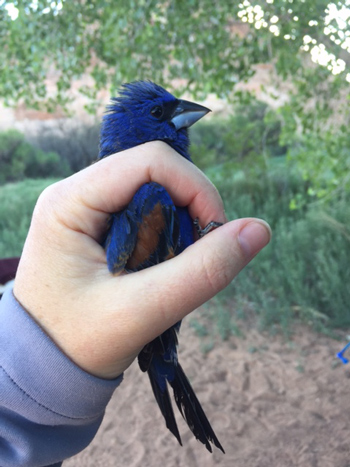 |
Sam and I just got back from
spending three fantastic days banding birds at the University of Utahís Rio
Mesa banding site about an hour outside Moab. Rio Mesa is the U of Uís
version of Lytle, and it was every bit as awesome. The mist nets are set up
along the Dolores River corridor and during peak can pick up some really
fantastic migrant species that use the river corridor to refuel along their
migratory journey. We visited right at the tail end of migration just as
everything is starting to settle down and nest, but we still got to see and
help band some pretty cool species such as Blue Grosbeak, McGillivrayís
Warbler, and Lucyís Warbler. I really think the birds made a
major migratory push overnight the second night we were there as the first
morning several species of birds were singing during the dawn chorus, and by
the next morning and the one after, that had changed drastically. |
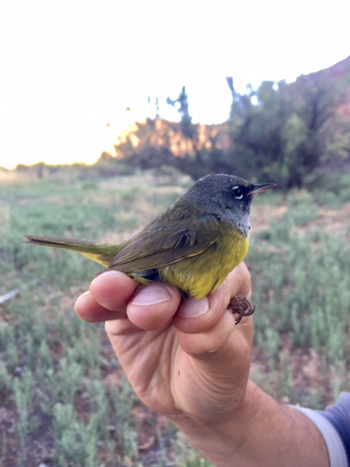 |
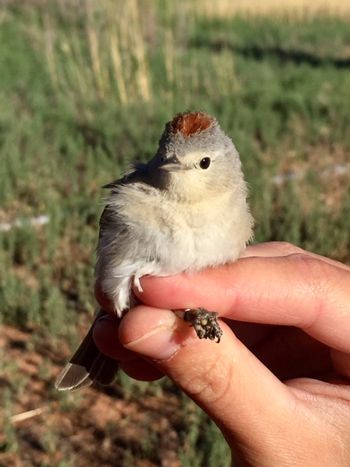 |
We did have one consistent singer the entire time (day and night) we were at Rio Mesa Ė a Northern Mockingbird with quite the impressive repertoire. I started keeping track of all of the species he was mimicking and came up with the following list: Ash-throated Flycatcher, Sayís Phoebe, Northern Flicker, Western Kingbird, Rock Wren, Juniper Titmouse, Cedar Waxwing, Plumbeous Vireo, Woodhouseís Scrub Jay, Bullockís Oriole, Broad-tailed hummer (male flight noise), and various gull and shorebird alarm noises. He was so good; in fact, some of the local vireos and kingbirds seemed quite put out he kept singing their songs.
|
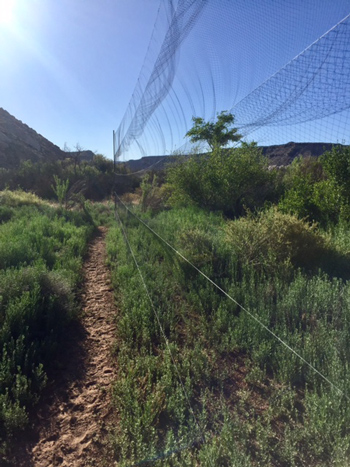 |
|
Banding occurs between sunrise and 6 hours
after sunrise so we had some free time in the afternoons to do a little
exploring and birding around the area. We headed out to Castle Valley one
afternoon on our trip, drove up toward the La Sal Mountain loop into the
Ponderosa forest, and hiked out to an amazing viewpoint that looked down
over Castle Valley. On that hike we picked up a breeding pair of Western
Bluebirds, Hammondís and Olive-sided Flycatchers, Pygmy Nuthatches, and
a few other species, which wasnít bad at all considering it was the middle
of the afternoon. On our drive back down I pulled the car over to take a
picture of the valley and it happened to be right next to a flock of
Bushtits. If you are ever in the Moab area, and you have some time to kill,
I highly recommend driving up along the Colorado River, up into Castle
Valley, and into the La Sals. You wonít be disappointed, thatís for sure.
Thatís all Iíve got for now. Hope you are all
having a wonderful spring migration, and as always, |
|
|
The
Frogmouth Hop
With a little research, along
with help from a newly found friend (a local volunteer I connected with on
birdingpal.org), I was overly optimistic concerning our chances.
Thanks to our detailed map, I knew exactly
where the birds should be found. However, locating a frogmouth turned out
to be a bigger challenge than we had expected. No matter how hard our
intrepid army of birders (my wife and 3 boys) looked, we could not track
one down. Feeling desperate, knowing that this was our last day in
Australia, I decided to phone a friend. Our birding pal came to the
rescue, and relayed that she was only a few minutes away from the park and
would be happy to join the search party (even though she had spent the
entire previous day with us). |
Click here for past 'Birds of the Month'.
|
Field Trip Reports |
|
|
Spanish Fork River Trail / Payson Hollow Park - 5 May 2018 by Lyle Bingham |
|
| We
started out at the park on top and it was WINDY and cold. So we went down to
the bottom to the sports park, where I knew it wouldn't be as windy. We had
a good walk to the first footbridge upstream from highway 198. Birds seen: Mallard, California Quail, Ring-necked Pheasant, Cooper's Hawk, Red-tailed Hawk, Killdeer, gull sp., Eurasian Collared-Dove, Mourning Dove (5), Lewis's Woodpecker, Downy Woodpecker (3), Say's Phoebe, Black-billed Magpie, Barn Swallow, Black-capped Chickadee, House Wren (3), American Robin, Cedar Waxwing, Yellow Warbler (4), Song Sparrow, Brown-headed Cowbird, Lesser Goldfinch, American Goldfinch, House Sparrow [View this checklist online at https://ebird.org/view/chec klist/S45309149] |
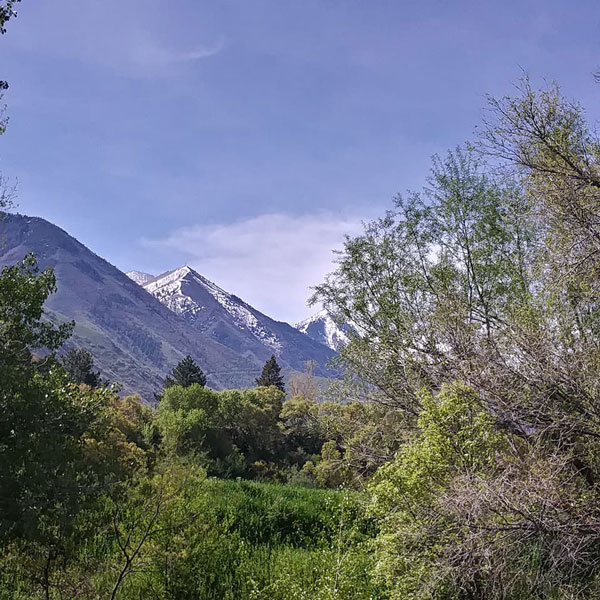 |
|
by Steve Van Winkle |
|
| Then
we walked back, drove up to the trail crossing at 1100 East and walked for
3/4 mile. Good birds there too. Birds seen: Mallard, House Wren, American Robin, European Starling, Yellow-rumped Warbler, Chipping Sparrow, Brown-headed Cowbird, House Finch, American Goldfinch, House Sparrow (some saw a White-crowned Sparrow and a Black-headed Grosbeak) [View this checklist online at https://ebird.org/view/chec klist/S45310112] |
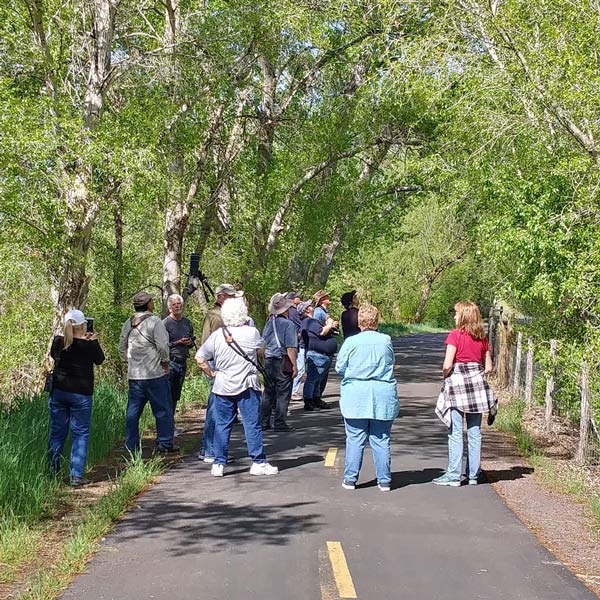 |
|
by Steve Van Winkle |
|
| Last we drove to
Payson Hollow Park and walked the concrete trails without much more than a
hummingbird (sp) in silhouette. When we walked south to the highline canal, we took the wild side and found birds. Birds seen: Ring-necked Pheasant, Cooper's Hawk, Red-tailed Hawk, hummingbird sp. (probably black chinned), Black-capped Chickadee, Song Sparrow, Spotted Towhee, Lazuli Bunting [View this checklist online at https://ebird.org/view/chec klist/S45310654] Everyone came over to the house to see Lazuli buntings, which were shy until they left. Some had seen them when we were walking the wild side :) Shortly thereafter we had 7 at the feeder. Birds seen: Spotted Towhee, Lazuli Bunting (5), House Finch, House Sparrow [View this checklist online at https://ebird.org/view/checklist/S45312615]
Cliff and I went to the cemetery afterwards and saw a barn owl. |
|
|
Utah County Hotspots Field Trip - 14 May 2018 by Suzi Holt |
|
| Twenty-two
Birders met early morning at 7. By Santaquin we had lost two to a flat tire
:( |
|
| We started our trip at Warm
Springs WMA with a BLUE GROSBEAK, Target bird -1!!!! We also got a VIRGINIA RAIL, Bullock's Orioles and heard lots of Yellow-breasted Chats and a Common Yellowthroat singing. Our next stop was the Goshen Ocean and it did not disappoint! There were Black-necked Stilts, Avocets, Long-billed Curlews, Wilson's Phalarope, Gadwall and Mallards. |
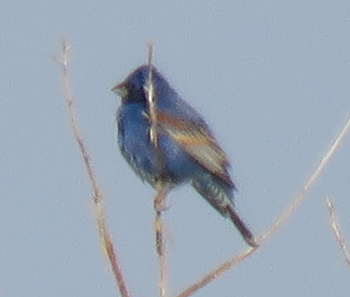 |
|
Blue Grosbeak |
|
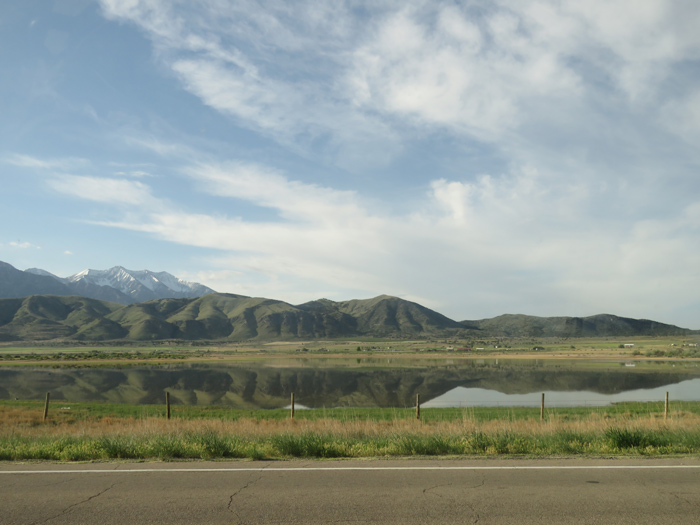 |
|
|
"Goshen Ocean" |
|
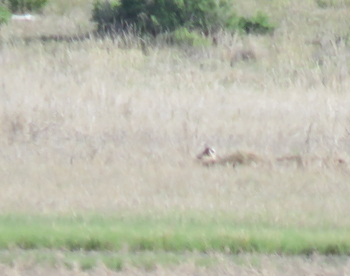 |
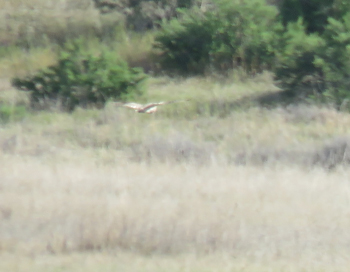 |
|
Then we checked out the fields
to the North spotting a SHORT-EARED OWL!!! Not everyone saw it :( but quite
a few did as it flew into the sage. |
|
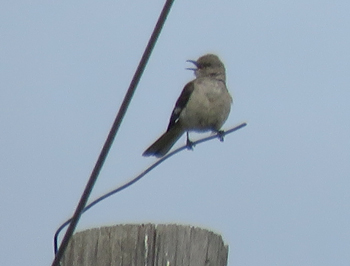 |
Goshen Cemetery Target bird - 2! NORTHERN MOCKINGBIRD! |
| Goshen Canyon we got great looks at 7 YELLOW-BREASTED CHATS Target bird -3! We also got the Canyon Wren, Rock Wren, Blue-Gray Gnatcatcher, Belted Kingfisher, Golden Eagle, 3 Great Blue Herons and Target bird -4 LAZULI BUNTING! | 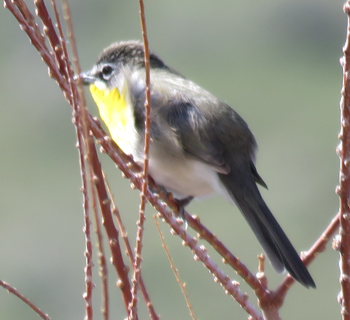 |
|
Yellow-breasted Chat |
|
| We worked our way towards Elberta Slant Road for a BURROWING OWL Target bird -5, GRAY VIREO Target bird -6! We also saw Spotted Towhee, Broad-tailed Hummingbird, Lark Sparrows and a Yellow-rumped Warbler. |
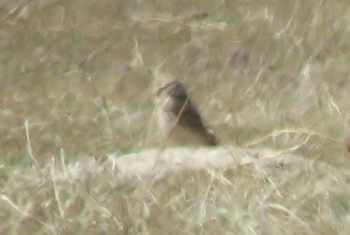 |
|
Burrowing Owl |
|
| At the pitstop in Eureka we
spotted a Mountain Bluebird and Cassin's Finches and met Mayor Carlton, a
really great guy. My favorite birding is in the East Tintic Mountains/Dividend Road. First stop BREWER"S SPARROW Target bird -7, Green-tailed Towhee Target bird -8, WARBLING VIREO Target bird -9, next corner surprise PLUMBEOUS VIREO, Black chinned Hummingbird, a cute little BUSHTIT, Chipping Sparrow, Turkey Vultures. Target bird -10, -11 and -12 were GRAY, DUSKY and CORDILLERAN Flycatchers! |
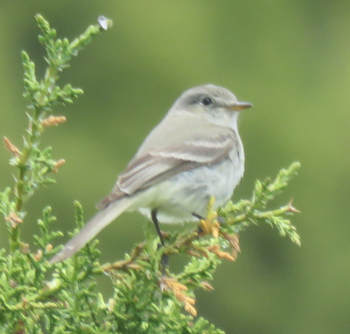 |
|
Gray Flycatcher |
|
| Next stop VIRGINIA'S WARBLER Target Bird -13. On the corner we heard a Juniper Titmouse Target bird -14. A surprise NORTHERN PYGMY OWL responded to the Titmouse call and about 10 of us heard it clearly! Down the road we got a couple a Red-breasted Nuthatch and BLACK-THROATED GRAY WARBLERS, Target bird -15!. Yeehaw!!! We were almost back to the main road where, by some Cottonwood trees, we saw Western Tanager, Western Wood Pewee, Yellow Warbler, Black-headed Grosbeaks and a Bewick's Wren! |
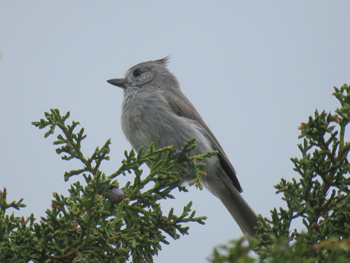 |
|
Juniper Titmouse |
|
| At that point we were at 95 Species we had to get to 100, so we decided to stop at Goshen Reservoir. We found a Spotted Sandpiper and Yellow-headed Blackbirds. At Secret Pond we got a BLUE-WINGED TEAL and Sand Hill Cranes. On Goshen Bay road we saw Great-horned Owl, Horned Larks and a SAVANNAH SPARROW. .We didn't want to quit so we went to Lincoln Beach. On the way we got Osprey, Tree Swallows, Caspian Tern and Eastern Kingbird. At Lincoln Beach there were Long-billed Dowitchers, RED-NECKED PHALAROPE, Least Sandpiper, Coots and a Ring-billed Gull. 109 Species!!!! | 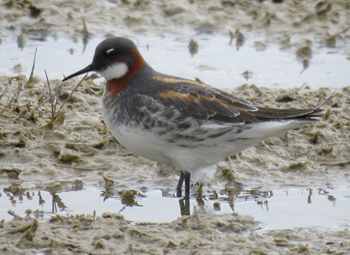 |
|
Red-necked Phalarope |
|
| Amanda, Mom and I finished the night with a White-breasted Nuthatch, California Quail ending at 111 Species! What a BIG DAY!!! | |
